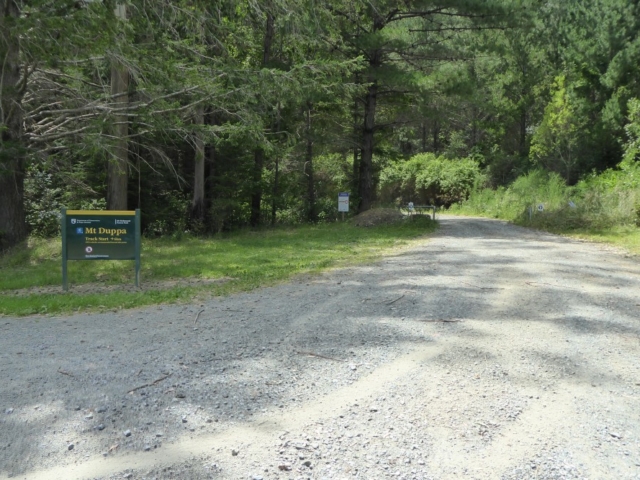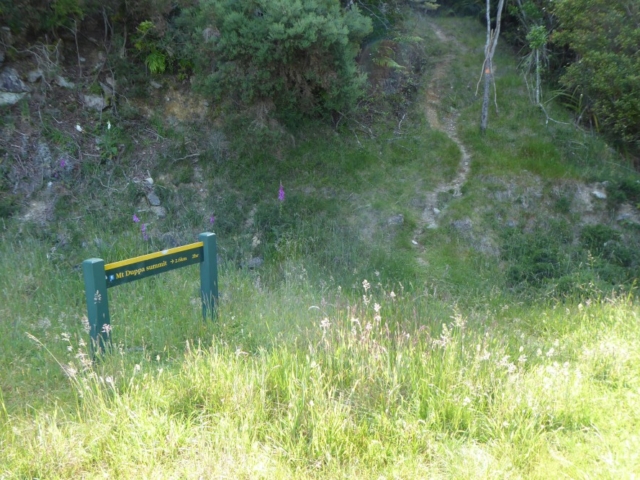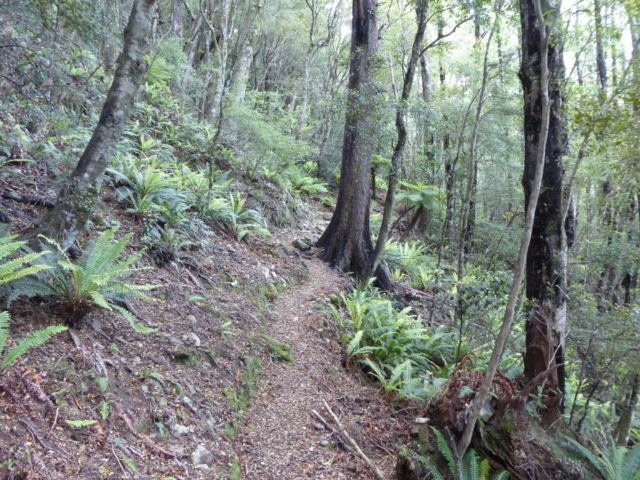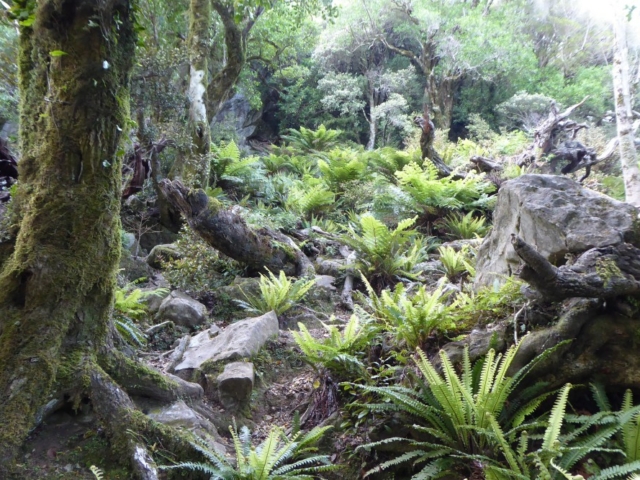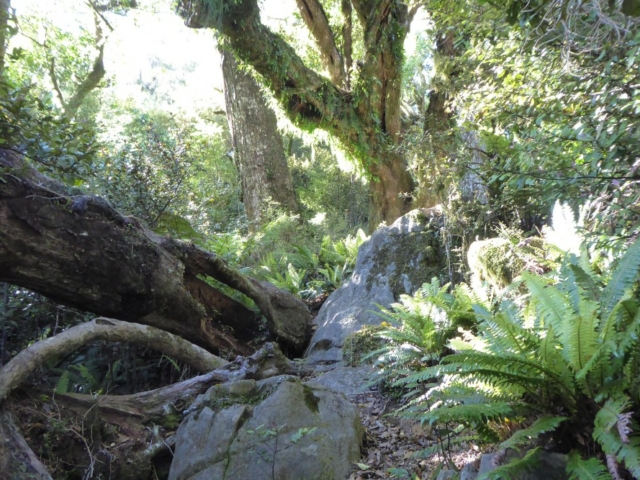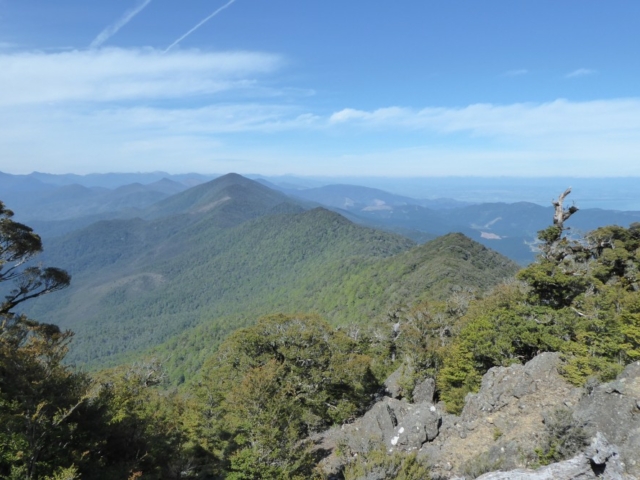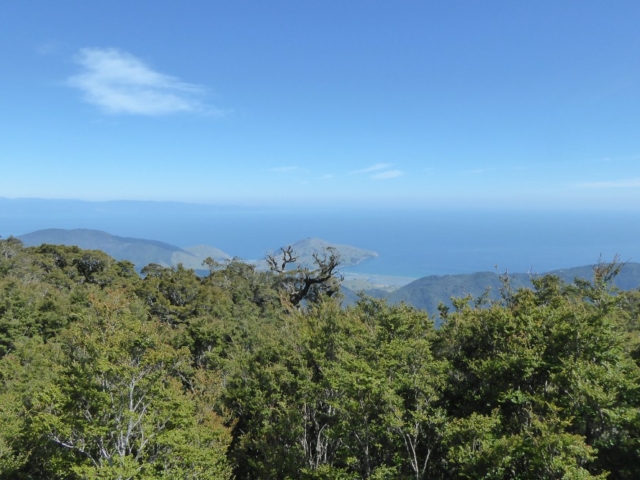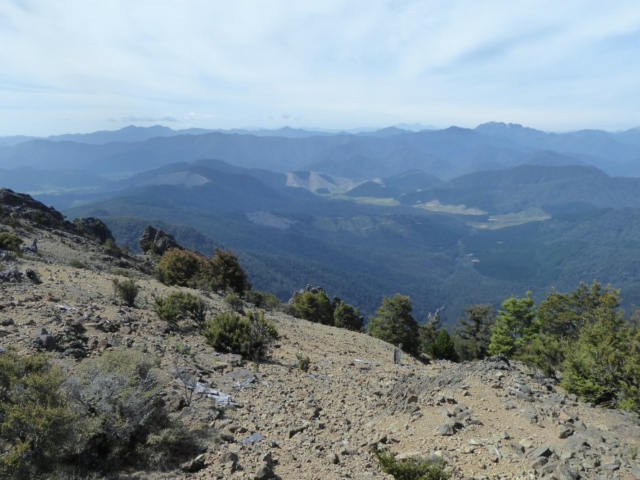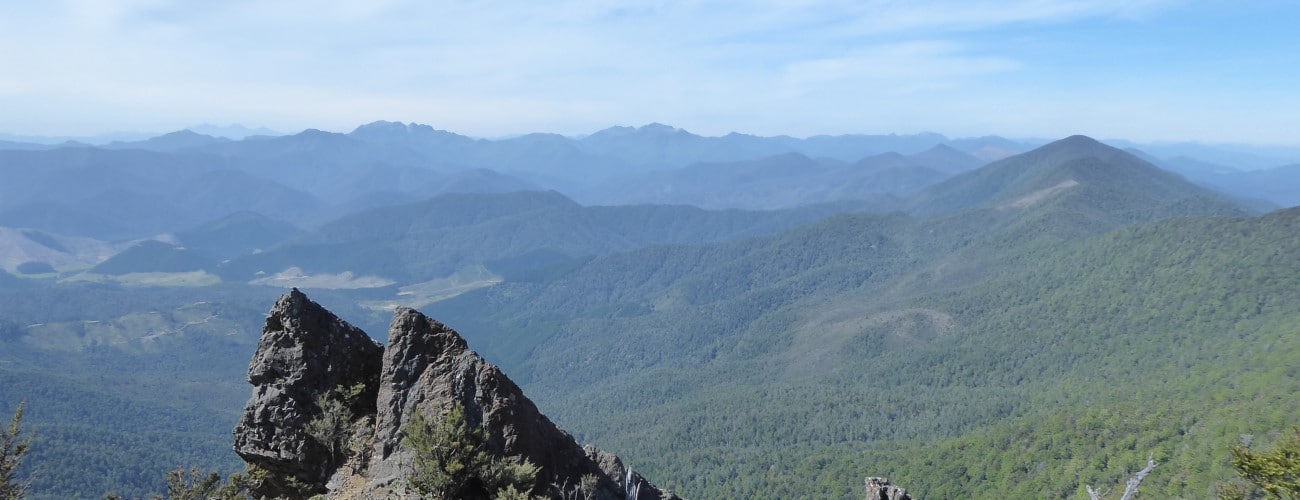
Mt Duppa (1143 m) is a peak at the northern end of Bryant Range, in Mt Richmond Forest Park. The track to the summit is short, but steep. The peak is named after George Duppa (1819–88), one of Nelson’s early European settlers and discoverer of chromite deposits on Wooded Peak.
| Details | |
| Length | 4.2 km return |
| Time Required | 3 hr return |
| Trail Type | Tramping track |
| Physical Difficulty | Moderate |
| Uses | Walking |
| Start Elevation | 520 m |
| Max Elevation | 1143 m |
If any layers fail to load, try clearing your cache and refreshing the page.
This elevation profile should be considered approximate. Its accuracy is determined by the quality of data available.
Mt Duppa Track does not connect to any other official tracks.
40 min from Nelson
Mt Duppa Track is accessed from State Highway 6 in Whangamoa Valley, 5.4 km north of Whangamoa Saddle. If you’re coming from Nelson, look out for the ‘Mt Duppa’ DOC sign on the right side of the road indicating the start of Hippolite Rd. Follow the orange markers up Hippolite Rd and then Bladebone Rd for approx. 6 km, until you reach the signpost at the track start. There is a turning area just uphill of the track where you can leave your vehicle. The track begins at the boundary between a forestry block and native forest (Mt Richmond Forest Park). As the forestry road gives vehicle access to 520 m elevation, the amount of climbing required to reach the summit is greatly reduced. A 4WD vehicle is recommended.
For trail runners keen for a bit more distance and elevation gain, you can park at the bottom next to the state highway and run up the access road. The uphill gradient is reasonably gentle and you’ll enjoy good views over the Whangamoa Valley.
Logging and high fire risk will close access.
From the road, the track zig-zags up the side of the spur for 700 m through beech and kamahi trees, and a thick undergrowth of crown ferns. Once at the crest of the spur, the gradient lessens briefly before the track reaches an impressive mass of limestone boulders, below which a gap in the canopy provides the first real opportunity for views. The track clambers steeply upwards through interesting limestone formations, and soon after you will notice the thick moss hanging off the trunks and branches of the surrounding trees. The track continues upwards at a reasonably consistent gradient for the remainder of the distance up the spur to the summit. Keep an eye out for the orange markers as the track is not always obvious.
You will reach the summit after around 1 hr. The summit is not a distinct point, but rather a ridge, which is forested on the northern side, but curiously treeless on the southern side, with crumbly scree and impressive craggy boulders of igneous origin jutting out of the steep slope that drops away to Tinline Valley far below. This allows for unobstructed views along the Bryant Range and further to the peaks of the Richmond Range. The geographical summit (1143 m) is marked by a pole in the middle of a cairn. Gaps in the beech trees allow views west toward Cable Bay and north to the Marlborough Sounds.
Return the way you came.
Mt Duppa is the location of two plane crashes. The first was in November 1956, when Alan Hackston was flying an Auster topdressing aircraft between Nelson and Blenheim. Thick fog caused him to crash into the top of Mt Duppa. He suffered serious injuries and spent a night alone in the bush, but was rescued and made a full recovery.
The other crash was in 2011, when former Olympic yachtsman Geoff Smale was killed after crashing his microlight plane. Mr Smale was en route to Ashburton when he hit Mt Duppa in cloudy and rainy conditions.
Mt Duppa (1143 m) is a peak at the northern end of Bryant Range, in Mt Richmond Forest Park. The track to the summit is short, but steep. The peak is named after George Duppa (1819–88), one of Nelson’s early European settlers and discoverer of chromite deposits on Wooded Peak.
| Details | |
| Length | 4.2 km return |
| Time Required | 3 hr return |
| Trail Type | Tramping track |
| Physical Difficulty | Moderate |
| Uses | Walking |
| Start Elevation | 520 m |
| Max Elevation | 1143 m |
This elevation profile should be considered approximate. Its accuracy is determined by the quality of data available.
40 min from Nelson
Mt Duppa Track is accessed from State Highway 6 in Whangamoa Valley, 5.4 km north of Whangamoa Saddle. If you’re coming from Nelson, look out for the ‘Mt Duppa’ DOC sign on the right side of the road indicating the start of Hippolite Rd. Follow the orange markers up Hippolite Rd and then Bladebone Rd for approx. 6 km, until you reach the signpost at the track start. There is a turning area just uphill of the track where you can leave your vehicle. The track begins at the boundary between a forestry block and native forest (Mt Richmond Forest Park). As the forestry road gives vehicle access to 520 m elevation, the amount of climbing required to reach the summit is greatly reduced. A 4WD vehicle is recommended.
For trail runners keen for a bit more distance and elevation gain, you can park at the bottom next to the state highway and run up the access road. The uphill gradient is reasonably gentle and you’ll enjoy good views over the Whangamoa Valley.
Logging and high fire risk will close access.
From the road, the track zig-zags up the side of the spur for 700 m through beech and kamahi trees, and a thick undergrowth of crown ferns. Once at the crest of the spur, the gradient lessens briefly before the track reaches an impressive mass of limestone boulders, below which a gap in the canopy provides the first real opportunity for views. The track clambers steeply upwards through interesting limestone formations, and soon after you will notice the thick moss hanging off the trunks and branches of the surrounding trees. The track continues upwards at a reasonably consistent gradient for the remainder of the distance up the spur to the summit. Keep an eye out for the orange markers as the track is not always obvious.
You will reach the summit after around 1 hr. The summit is not a distinct point, but rather a ridge, which is forested on the northern side, but curiously treeless on the southern side, with crumbly scree and impressive craggy boulders of igneous origin jutting out of the steep slope that drops away to Tinline Valley far below. This allows for unobstructed views along the Bryant Range and further to the peaks of the Richmond Range. The geographical summit (1143 m) is marked by a pole in the middle of a cairn. Gaps in the beech trees allow views west toward Cable Bay and north to the Marlborough Sounds.
Return the way you came.
Mt Duppa is the location of two plane crashes. The first was in November 1956, when Alan Hackston was flying an Auster topdressing aircraft between Nelson and Blenheim. Thick fog caused him to crash into the top of Mt Duppa. He suffered serious injuries and spent a night alone in the bush, but was rescued and made a full recovery.
The other crash was in 2011, when former Olympic yachtsman Geoff Smale was killed after crashing his microlight plane. Mr Smale was en route to Ashburton when he hit Mt Duppa in cloudy and rainy conditions.
Mt Duppa Track does not connect to any other official tracks.
Updated 30 December 2019
